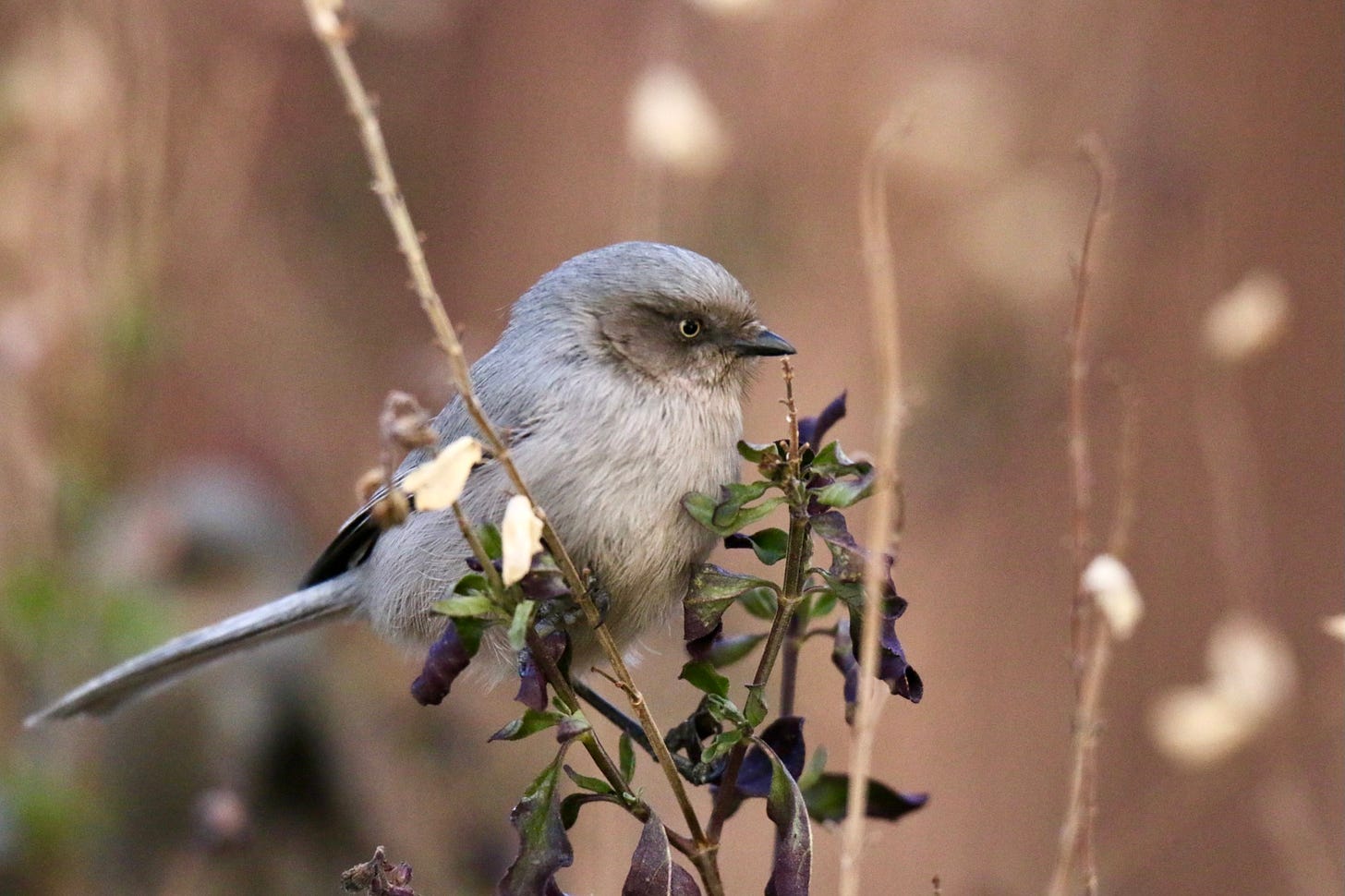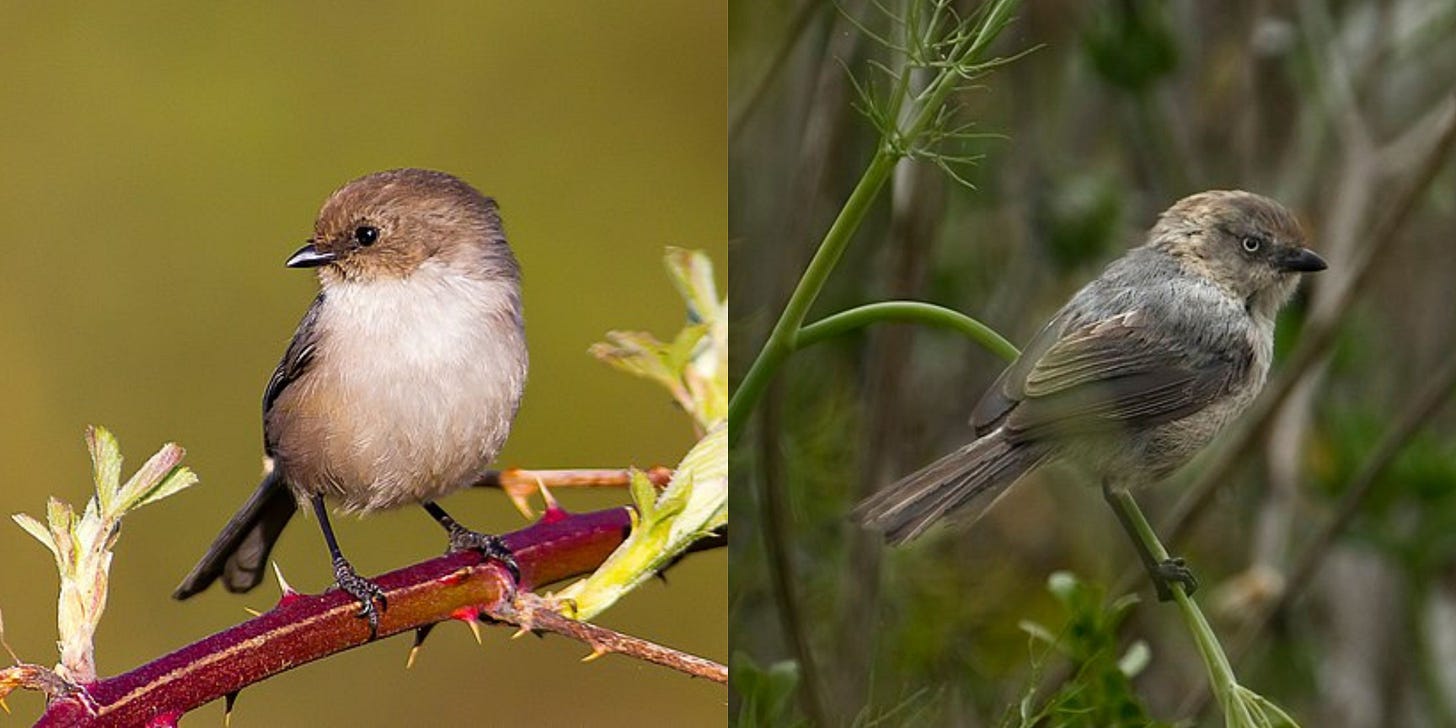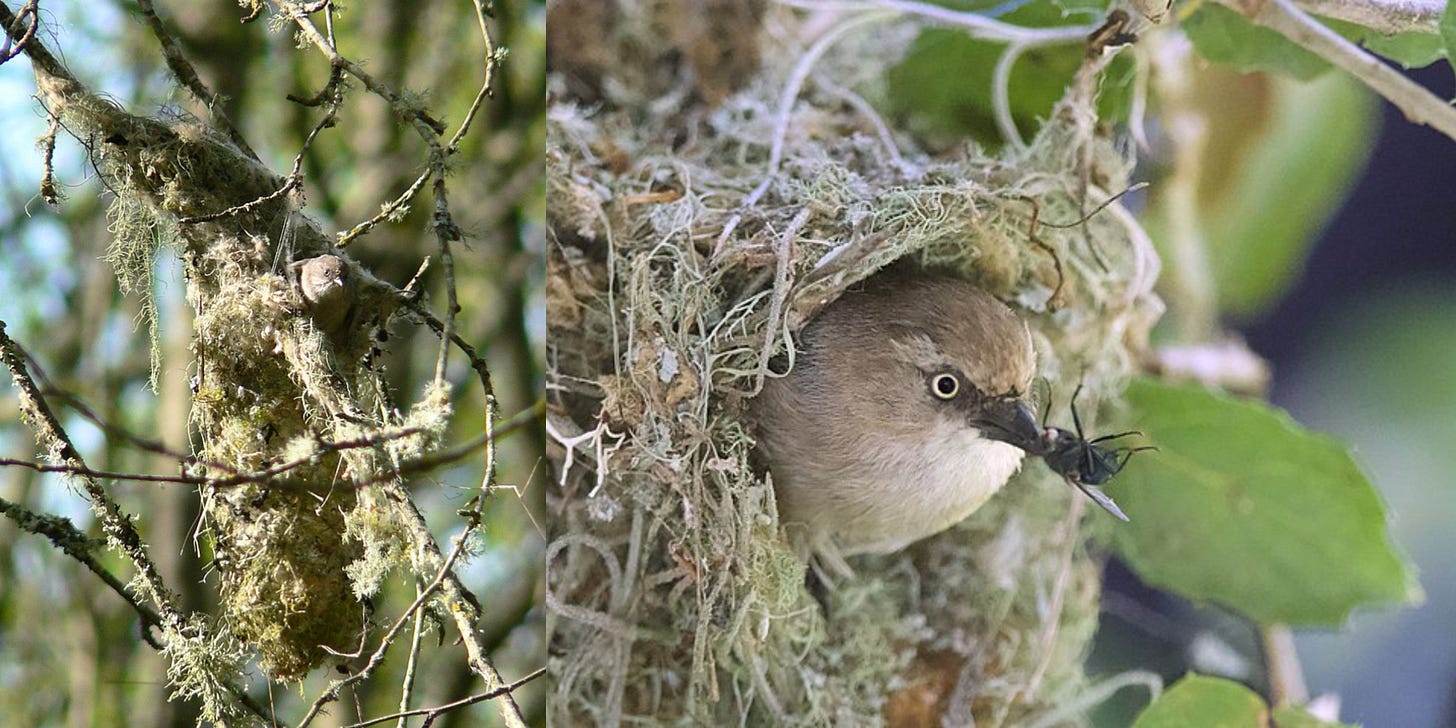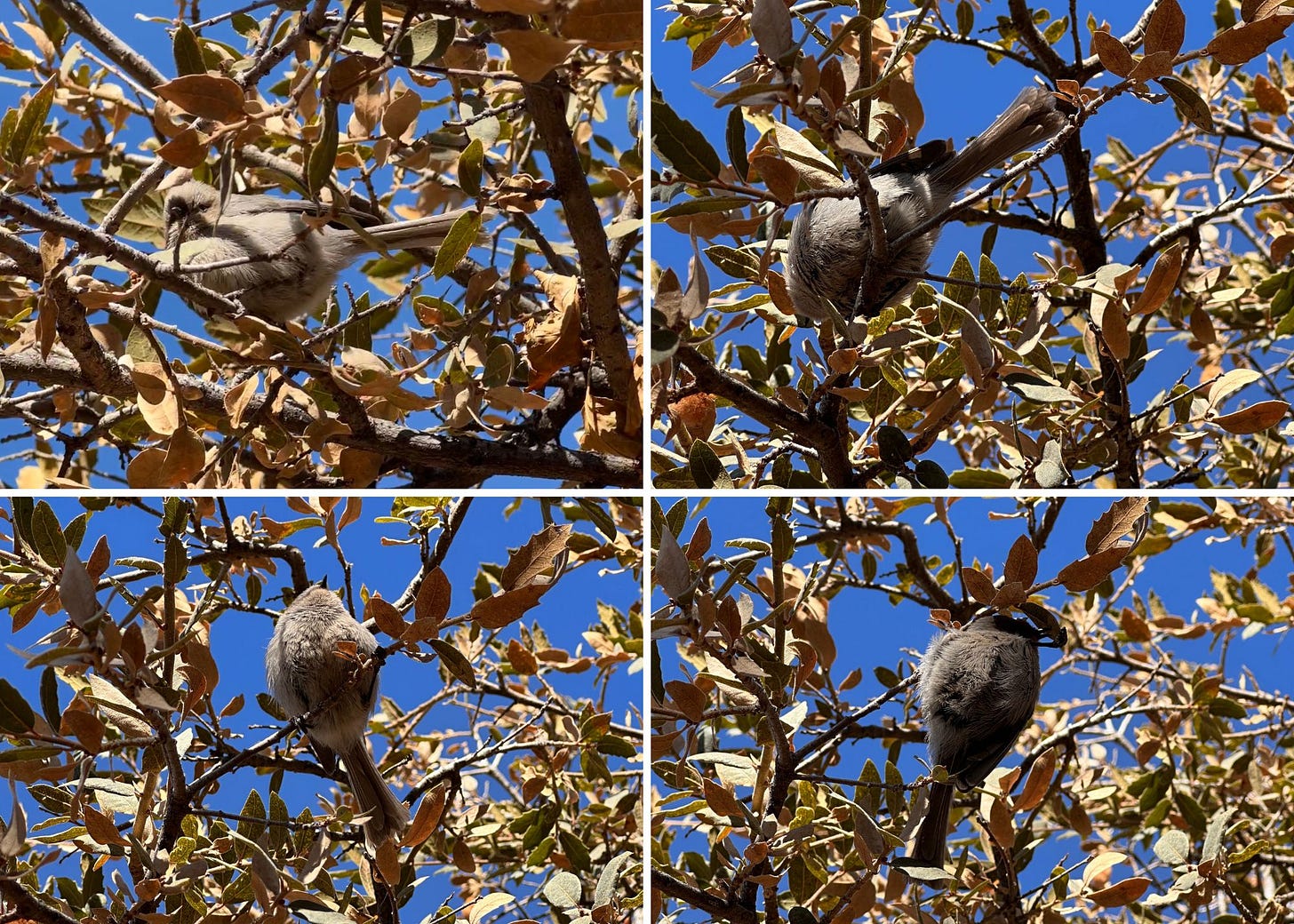
You always hear them before you see them, dozens of tinkling voices, of jubilant trills, emanating from the shrubs and scrubby trees on all sides of you. You find yourself immersed in the incessant chirping dialogue of many tiny, tender creatures reassuring each other.
You squint your eyes, crane your neck, and spin in circles scanning the foliage. Occasionally, your brain registers the tiniest flash of movement here and there, the merest flicker of a shadow. It could’ve been nothing more than a leaf agitated by an imperceptible breeze, or the light changing as a wispy cloud clips the edge of the sun. But the gentle peeps continue in a symphony you feel at soul-depth.
Then something tiny leaps out from the scrub oak you had just studied at length and deemed empty, calling brightly as it does so. It dives not like a creature endowed with wings, but as if it is jumping out a plane with a squirrely parachute. It’s visible for a half-second before it disappears safely into the neighboring juniper. It is immediately followed by another just like it.
Then another. Then another. A veritable procession bounds between these two trees, intermittent and incessant as a faucet dripping. Every time you are certain that that is the last of them, that there can’t be more, another one leaps courageously through the open space.
You count them until you lose count. It’s mind-boggling how many bushtits can conceal themselves in one unassuming shrub. Like a clown car, it defies the rules and logic of objective space. Perhaps these little creatures are not beholden to the same laws of physics as we are.
Now that you know they’re really there, you stare harder at the tree they’ve all vanished into, until a flip switches in your field of vision. You finally fix your eyes on one – a spectacularly small, mousy gray bird, with a long slender tail and utterly no neck to speak of. Its plump body and blocky head form one silky, rotund whole. It hops and shimmies from branch to branch, probing the crevices of leaves and twigs with the stubbiest black bill you’ve ever seen, more miniscule than a single sunflower seed. Sometimes it flips and hangs upside down to probe the hardest-to-reach nooks and crannies. You spot more and more of them, until you can barely keep track of each one milling about in your periphery.
In field guides, you’ll sometimes find bushtits described as “drab,” “plain,” or “nondescript.” Sure, they lack the intricate patterns, bold colors, and feathery flourishes that easily win the adoration of bird watchers. But one could say the same thing of clouds gathering in a dark gray sky before a thunderstorm – they don't much appeal to our sense of color, but they inspire awe with their palpable energy, their dynamism, their literal electric charge.
Each one weighs less than a roasted marshmallow, and yet a flock of bushtits transforms every space they pass through. Many times have I halted in my tracks, seized by forces beyond myself, frozen in wonder, as the bushtits came and went. Nothing about a rollicking band of chattering, tree-hopping ping-pong balls come-to-life could earnestly be deemed “plain.”
One warm fall morning, I was out back filling my bird feeders. This is generally the one time of day that there are no birds in the backyard, save for perhaps a dove or some finches watching me from the safety of the powerlines far overhead. The sparrows and finches flee their posts if I so much as stand too close to the glass backdoor – they wouldn’t dream of coming near me while I’m tampering with their precious food source.
Carefully I poured a cup of seed into the top of my fence-mounted feeder, then spun around and nearly crashed into the hanging suet block to which five bushtits were clinging. The unmistakable voices of many more were twinkling from the branches all around my head as I stood frozen beneath the small scrub oak tree. I couldn’t quite tell if they mistook me for an extension of the tree itself or dismissed me entirely. Either way, my presence was no obstacle to this roaming flock ravenous for a fat-rich breakfast – the suet block spun slowly as the bushtits dug in with no mind for my person frozen two feet away from them.
In my experience, hummingbirds are the only other tiny birds that tolerate human proximity like the bushtits do. But unlike the territorial hostility of egotistical hummingbirds, who will fly right in your face in hilarious attempts to intimidate you off their turf, bushtit flocks will approach you it seems because they simply do not care that you’re there. They are foliage gleaners, busy hunting insect prey so tiny we could barely see them without the aid of magnification. We megafauna are simply too large and slow to register as a threat, possibly to even register as a living thing – we’re just strange, fleshy, ambulatory trees, without all the yummy invertebrates.
Of course, any sudden movements or ill intentions on our part will result in the bushtits’ quick retreat. But if we remain calm and move slowly, bushtits readily allow us to blend into the scenery in a way few other wild creatures do. And there is no greater blessing on Earth for a naturalist than to meld with the environment and see what other beings do when they are not disturbed by human presence.
One cannot help but feel like a Disney Princess when a flock of itty bitty songbirds land within arm’s reach, but you have to remember the bushtits are not approaching you because you’re special, because you’re the chosen one, or because they care about you. They are close because they do not care about you, and this gentle indifference is in fact the wellspring of the joy you feel in their presence.
In trying to string together words that do some semblance of justice to the magic of bushtits, I’ve been periodically swept away by fantastical notions that bushtits were seeking me out and cheering me up on purpose, that they benefitted energetically from the exchange. But the reality – that bushtits spread joy to humankind not only without expecting anything in return, but without any awareness, simply by being themselves – is more beautiful than any fantasy I could invent.
In a world where humans are such a thoroughly destructive force, what a relief it is to find moments of neutrality, where you are not viewed by other creatures with suspicion or fear, but merely not viewed at all. These minuscule beings make me feel my own smallness, my inconsequence, as a blessing.

The studies scientists have undertaken of bushtit society have so far revealed it to be cooperative, nurturing, and peace-loving. In these ways, it is much more advanced than our own. Cooperative breeding and communal children rearing are sophisticated social systems which our stunted culture has veered far from, in favor of the fetishization of the insulated nuclear family. But the bushtits live by something we sometimes say but rarely take to heart – it takes a village to raise a child.
Bushtits are one of a few bird species – along with the Southwest’s iconic acorn woodpeckers – known to raise their young communally, rather than leaving the responsibility up to their biological parents alone. This unusual social configuration is made even more exceptional by the fact that the “helpers-at-the-nest” – the non-breeding adults who help with the labor of feeding and protecting the young – are usually adult males. Rather than raging on the internet and committing mass shootings like the young male incels who fail to “breed” in our human society, young male bushtits step up to help their species and gain experience with child care by assisting a mated pair from their flock. They don’t even have to be relatives. This is quite an enlightened response to the failure to find a mate.
It is moreover one of nature’s countless reminders that male and female social roles are entirely dependent on the societies from which they emerge, not determined by the mere biology of the sexes. Non-breeding bushtits can be said to be expressing a third gender, fulfilling a distinct social need from the breeding males and females. All of these social configurations are “natural,” as in occurring in nature, and that it is blatantly unscientific and illogical to declare otherwise, as our government has just done on the federal level.
Each spring when it is time to breed, the little bushtits weave intricate hanging pouch nests using spider webs, feathers, fur, and plant matter, in a meticulous process that can take a month or more. Almost all other birds reserve their nests for their young and the adult who is actively keeping them warm, but not the bushtits. They’ve worked too hard not to enjoy the comforts of their ornate construction together. The whole breeding collective, including the helpers-at-the-nest, sleep snuggled in their hanging nest each night – it is so adorable, I can bring myself to tears just imagining it.
It is vital to hold onto these tender images of compassionate wildness when we wake up every day under government leaders that would rather assert and expand their power than help people take care of each other. It is unconscionable to prioritize annexing Greenland and making it to Mars over fixing our broken health care system, providing shelter for the unhoused, aiding victims of natural disaster, and healing our polluted environment. Care work is the foundation of all our lives and the only work that truly matters. A society that does not prioritize meeting the basic needs of its people is not a society that supports life, liberty, or the pursuit of happiness. It’s a society that guarantees needless death, suffering, and despair. The bushtits know this obvious truth.
Another reason bushtits live so harmoniously is that they lack any strongly-held notions of private property. Even during the breeding season, when most birds exhibit extreme aggression towards intruders in the territory they’ve temporarily claimed for nesting, bushtits rarely get riled up. They will tolerate other birds nesting nearby them, even pilfering some nesting material from them, as long as they leave their young alone. Their tolerance is not merely because they are small and meek, for it is extremely common for birds to pick fights with creatures much bigger and stronger than them, especially when they have strength in numbers. Think of a band of crows mobbing a Red-Tailed Hawk, or a lone seagull harassing a Bald Eagle.
I maintain the pacifism of bushtits springs from a deeper source of wisdom, and the visceral knowledge that the collective is more essential to survival than the individual. In the winter time, bushtits intermingle with and even sleep among other bushtit flocks they come across as they roam the scrublands of the American West, in search of the invertebrate food which becomes so scarce in the cold months. Because their ratio of surface area to body mass is so high, the bushtits must cuddle for warmth to endure the freezing winter nights. During particularly brutal freezes, the birds on the outside sometimes perish as they heat those on the inside of the flock.
Nor is it uncommon to spot kinglets, chickadees, titmice, and other exceedingly petite birds hanging out in a flock of bushtits, foraging alongside them – anybody who is small and in need of the protection of a flock is welcome to join them. The larger the group to travel and cuddle with, the better the chances of survival for all.
In this time when our corrupt leaders are trying to mandate that we reject “intruders,” that we hate people who are different from us, that we defend what is “ours” to the death, I am looking to emulate these wiser creatures. They can make all the laws they want, but the law does not dictate what is in our hearts, nor what we manifest with our actions.
Interdependence, not independence, is our natural state. To bastardize a line from Kierkegaard which came to me via Dune Part 1, interdependence is not a problem to solve, but a reality to experience. It must be embraced. This truth is so obvious to the bushtits, it would never occur to them to question it. None of us will ever escape it. Not even the billionaires, who have astronomically more material wealth than they could ever need, but still obsessively fight for our adoration and our obedience to their regressive visions of the world.
We are all much more vulnerable than we are capable of acknowledging, but when the vulnerable lift each other up and look out for each other, we can survive anything. This seems to me the only way to endure a future that looms increasingly dark. Increasing the wellbeing of ALL children, not the wellbeing of OUR children, is how we secure our continued existence on this planet. Scapegoating groups of fellow vulnerable humans does nothing to help us solve any of the problems we face.
But let me never lose sight of the bushtits. Bushtits live according to their caring nature, looking out for each other as they do themselves. They would never capitulate to the nonsensical notion that every man or every bird is an island, which stands in visceral contradiction to everything they have ever lived through. I believe their nature is our nature, too.
And what a beautiful world we still stand to have if we lived more like the bushtits.






Bravo Carly, bravo! Patrick Henry (1799) said it best, "United we stand, divided we fall." Bushtits get it, why can't all men?
You have said what so many of us feel.No man is an island and we al need to stand together and pray that our country and this world will weather the current so called leadership we have.Your writing is always so uplifting and I really enjoy reading it.I hope you have a wonderful day and keep doing great things.LoveAunt Jeannie